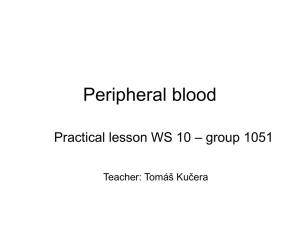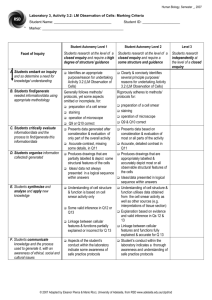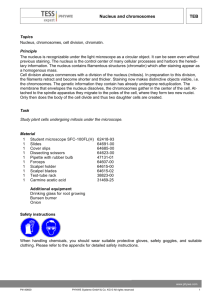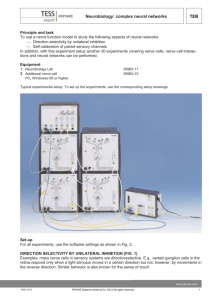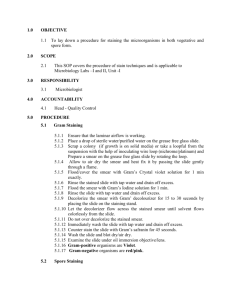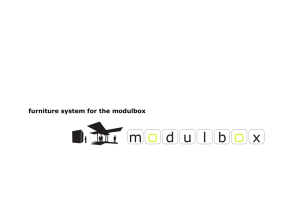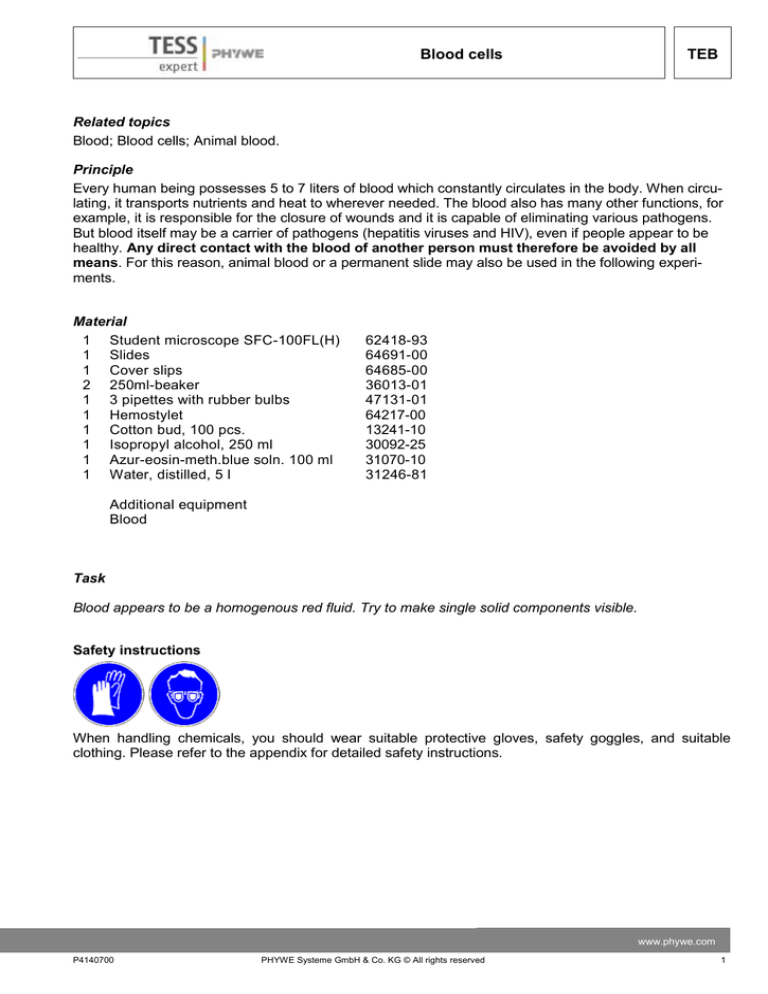
Blood cells
TEB
Related topics
Blood; Blood cells; Animal blood.
Principle
Every human being possesses 5 to 7 liters of blood which constantly circulates in the body. When circulating, it transports nutrients and heat to wherever needed. The blood also has many other functions, for
example, it is responsible for the closure of wounds and it is capable of eliminating various pathogens.
But blood itself may be a carrier of pathogens (hepatitis viruses and HIV), even if people appear to be
healthy. Any direct contact with the blood of another person must therefore be avoided by all
means. For this reason, animal blood or a permanent slide may also be used in the following experiments.
Material
1 Student microscope SFC-100FL(H)
1 Slides
1 Cover slips
2 250ml-beaker
1 3 pipettes with rubber bulbs
1 Hemostylet
1 Cotton bud, 100 pcs.
1 Isopropyl alcohol, 250 ml
1 Azur-eosin-meth.blue soln. 100 ml
1 Water, distilled, 5 l
62418-93
64691-00
64685-00
36013-01
47131-01
64217-00
13241-10
30092-25
31070-10
31246-81
Additional equipment
Blood
Task
Blood appears to be a homogenous red fluid. Try to make single solid components visible.
Safety instructions
When handling chemicals, you should wear suitable protective gloves, safety goggles, and suitable
clothing. Please refer to the appendix for detailed safety instructions.
www.phywe.com
P4140700
PHYWE Systeme GmbH & Co. KG © All rights reserved
1
TEB
Blood cells
Methods and observations:
1. The constituents of blood
Gather information on the composition of blood and the functions of each single blood constituent.
Complete the sentence: Blood contains the following cells as solid constituents:
……………………………………………………………………………………………………………..
Which of these cell types do you expect to see in a very great number under
the microscope? (underline them!)
2. Blood source
Variant A: The teacher will make a blood sample containing an anticoagulant
agent available to you. Prepare a slide etc.
Variant B: You prefer to examine your own blood!
First thoroughly clean a slide and prepare all materials you need.
Massage the finger from which you intend to take your own blood sample. Disinfect your finger tip with
propanol. Take the hemostylet out of the original package (only to be used for this purpose!). Use the
stylet to scratch or punch your finger until blood emerges. The first drop is discarded, the second is allowed to drip directly onto the slide.
3. Rapid blood examination
The drop of blood is diluted with water and swiftly viewed under the microscope (up to 400-fold).
Note: If you insert an extra (broken) cover slip as a spacer between your slide and the regular cover slip,
you will be able to better identify the shape of the blood cells!
What are the blood cells called which you see in a great number?
Drawing:
2
PHYWE Systeme GmbH & Co. KG © All rights reserved
P4140700
TEB
Blood cells
4. Staining a blood smear
The slide should be placed on a firm substrate for this staining procedure.
Drip some blood on the slide as described under 2.
Place one edge of a cover slip next to it so that it contacts the blood and then pull it away from the
blood drop. This will cause the blood to smear across the slide in a thin layer and the cells will not be
damaged.
Allow to dry for 5 minutes.
Apply several drops of the azure II eosin Methylene Blue solution and allow it to take effect for 2
minutes.
Add several drops of distilled water and wait 2 to 3 minutes.
Rinse with plenty of distilled water.
Allow to air dry.
5. Microscopy of a blood smear
Examine the blood smear or a permanent slide.
Describe the appearance of the various constituents stained. What kind of blood cells are there?
…………………………………………………………………………………………………………………………
…………………………………………………………………………………………………………………………
…………………………………………………………………………………………………………………………
www.phywe.com
P4140700
PHYWE Systeme GmbH & Co. KG © All rights reserved
3
TEB
Blood cells
Information on obtaining materials
Whether human blood may be examined during school lessons depends on the safety regulations of
each state. Any contact with blood might lead to an infection with the pathogens HIV, hepatitis,
etc. Dried blood might also result in the transmission of hepatitis viruses, for example. For this
reason, the general rules of hygiene must be observed by all means (see below).
Alternatively, these studies may be conducted with fresh, yet unclotted animal blood samples. It can be
ordered at a butcher’s shop and must be treated for the following experiments with an anticoagulant (e.g.
citrate) upon its withdrawal.
Information on practical performances
1. Blood constituents
The students should make themselves familiar with the various blood constituents in advance. The blood
cells (red blood corpuscles and platelets), of which the red blood cells predominate by number, stand in
the center of interest.
2. Blood source
Variant A: Small amounts of animal blood pretreated with citrate are made available to the students in a
beaker. All the following tests can be performed with this one sample.
Variant B: The following safety rules must be observed:
Isopropanol or ethanol (or a mixture of both) and swab (tissue paper, or similar) must be in reach.
The puncture site must be disinfected before a sample is taken and protected from being contaminated by pathogens afterwards (plaster).
Hemostylets must only be used once and are then discarded in a sealed container, so that other
persons are safe from injury or infection.
All work top surfaces and materials (slides) which might have been in contact with the blood must
be disinfected after the experiment.
3. Rapid blood examination
A rapid examination is necessary because plasmolysis of the cells will ensue. In this experiment (without
staining) only red blood corpuscles are recognizable, predominately occurring in the shape of round
discs. That they are lentiform or plate-shaped may be seen exceptionally, for example, when the cells
are visible from an oblique angle. This happens only when a spacer is used (cf. information in the students’ worksheet).
Blood (human) 400x, unstained
4
Blood (mammal) 400x, unstained
PHYWE Systeme GmbH & Co. KG © All rights reserved
P4140700
Blood cells
TEB
4. Staining
The students are to handle staining agents with care in order not to contaminate tables and clothing.
Working on tiled surfaces with a sink is recommended.
5. Microscopy of the blood smear
The quite large and diverse white blood cells are stained differentially. With some luck, the irregularly
shaped platelets may also be seen in groups.
Blood smear 400x, stained with azure II eosin methylene blue
www.phywe.com
P4140700
PHYWE Systeme GmbH & Co. KG © All rights reserved
5
TEB
Blood cells
Appendix
Hazard symbols, signal word
Hazard statements
Precautionary statements
H225: Highly flammable
liquid and vapour.
H301+311+331: Toxic if
swallowed, in contact with
skin or if inhaled.
H370: Causes damages
to organs.
P210: Keep away from
heat/sparks/open
flames/hot surfaces. –
No smoking.
233: Keep container
tightly closed.
P240: Ground/bond container and receiving
equipment.
P280: Wear protective
gloves/protective clothing.
P302+352: IF ON SKIN:
Wash with plenty of soap
and water.
P304+340: IF INHALED:
Remove victim to fresh
air and keep at rest in a
position comfortable for
breathing.
P309+310: IF exposed
or if you feel unwell immediately call a POISON
CENTER or doctor/physician.
P403+P235: Store in a
well-ventilated place.
Keep cool.
H225: Highly flammable
liquid and vapour.
H319: causes serious eye
irritation.
H336: May cause drowsiness or dizziness.
P210: Keep away from
heat/sparks/open
flames/hot surfaces. –
No smoking.
P233: Keep container
tightly closed.
P305+351+338: IF IN
EYES: Rinse cautiously
with water for several
minutes. Remove contact lenses, if present
and easy to do. Continue
rinsing.
Azur eosin methylene blue solution
Danger
Isopropyl alcohol
Danger
6
PHYWE Systeme GmbH & Co. KG © All rights reserved
P4140700
Blood cells
TEB
www.phywe.com
P4140700
PHYWE Systeme GmbH & Co. KG © All rights reserved
7

